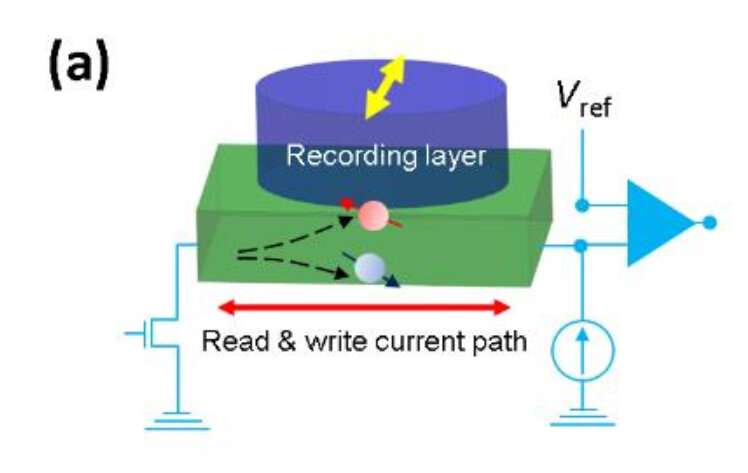Paving the way for spintronic RAMs: A deeper look into a powerful spin phenomenon

Scientists at Tokyo Institute of Technology (Tokyo Tech) report a new material combination that sets the stage for magnetic random access memory based on spin, an intrinsic property of electrons. The innovation could outperform current storage devices. Their breakthrough, published in a new study, describes a novel strategy to exploit spin-related phenomena in topological materials and could spur several advances in the field of spin electronics. Moreover, this study provides additional insight into the underlying mechanism of spin-related phenomena.
Spintronics is a modern technological field where the spin, or the angular momentum, of electrons takes a primary role. In fact, collective spin arrangements are the reason for the curious properties of magnetic materials, which are popularly used in modern electronics. Researchers have been trying to manipulate spin-related properties in certain materials, especially for non-volatile memory. Magnetic non-volatile memory, (MRAM) has the potential to outperform current semiconductor memory technology in terms of power consumption and speed.
A team of researchers from Tokyo Tech, led by Associate Professor Pham Nam Hai, recently published a study in the Journal of Applied Physics on unidirectional spin Hall magnetoresistance (USMR), a spin-related phenomenon that could be used to develop MRAM cells with an extremely simple structure. The spin Hall effect leads to the accumulation of electrons with a certain spin on the lateral sides of a material. The spin Hall effect, which is particularly strong in materials known as topological insulators, can result in a giant USMR by combining a topological insulator with a ferromagnetic semiconductor.
When electrons with the same spin accumulate on the interface between the two materials, due to the spin Hall effect (Fig. 1), the spins can be injected to the ferromagnetic layer and flip its magnetization, allowing for memory write operations, which means the data in storage devices can be rewritten. At the same time, the resistance of the composite structure changes with the direction of the magnetization owing to the USMR effect. Resistance can be measured using an external circuit, allowing for memory read operations in which data can be read using the same current path with the write operation. In existing material combination using conventional heavy metals for the spin Hall effect, however, the changes in resistance caused by the USMR effect are extremely low—well below 1 percent—which hinders the development of MRAM using this effect. In addition, the mechanism of the USMR effect seems to vary according to the combination of material used, and it is not clear which mechanism can be exploited for enhancing the USMR to over 1 percent.
To understand how material combinations can influence the USMR effect, the researchers designed a composite structure comprising a layer of gallium manganese arsenide (GaMnAs, a ferromagnetic semiconductor) and bismuth antimonide (BiSb, a topological insulator). With this combination, they obtained a giant USMR ratio of 1.1 percent. In particular, the results showed that exploiting two phenomena in ferromagnetic semiconductors, magnon scattering and spin-disorder scattering, can lead to a giant USMR ratio, making it possible to use this phenomenon in real-world applications. Dr. Hai says, "Our study is the first to demonstrate that it is possible to obtain an USMR ratio larger than 1 percent. This is several orders of magnitude higher than those using heavy metals for USMR. In addition, our results provide a new strategy to maximize the USMR ratio for practical device applications."
This study could play a key role in the development of spintronics. Conventional MRAM structure requires about 30 ultrathin layers, which is very challenging to make. By using USMR for read-out operations, only two layers are needed for the memory cells. "Further material engineering may further improve the USMR ratio, which is essential for USMR-based MRAMs with an extremely simple structure and fast reading. Our demonstration of an USMR ratio over 1 percent is an important step toward this goal," concludes Dr. Hai.
More information: Nguyen Huynh Duy Khang et al, Giant unidirectional spin Hall magnetoresistance in topological insulator – ferromagnetic semiconductor heterostructures, Journal of Applied Physics (2019). DOI: 10.1063/1.5134728
Journal information: Journal of Applied Physics
Provided by Tokyo Institute of Technology





















